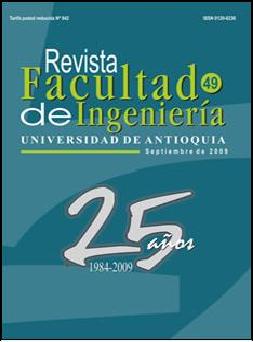Biomass gasification process in a downdraft fixed bed gasifier: a real time diagnosis model based on gas composition analysis
DOI:
https://doi.org/10.17533/udea.redin.15801Keywords:
Biomass gasification, monitoring, diagnosis, gas composition, process controlAbstract
This article is focused on the diagnostic technique used in the Thermal Engines Laboratory of the University of Valladolid (Spain), to perform real time calculation, monitoring and recording of gasification physical variables, only from gas composition analysis and some other measurements such as local temperatures and gas flow rate. By assuming some simplifying hypothesis it is possible to calculate the main gasification parameters such as biomass consumption, air/fuel ratio, thermal efficiency, and generated thermal power. The aim of this work is to explain the technique implemented and to give an idea of the wide range of applications that it can have, underlining its simplicity, its reliability and the low costs of the equipment needed.
Downloads
References
S. R. Turns. An introduction to combustion. Concepts and Applications. Ed. McGraw-Hill. Inc. Singapore. 1996. pp. 20-75.
R. S. Spindt. “Air-fuel ratios from exhaust gas analysis”. SAE Tech. Pap. Ser. Vol. 650507. 1965. pp. 788-793. DOI: https://doi.org/10.4271/650507
C. R. Altafini, A. Mirandola. “A chemical equilibrium model of the coal gasification process based on the minimization of the gibbs free energy”. Proceedings of Florence World Energy Research Symposium- FLOWERS’97. 1997. pp.419-427.
C. R. Altafini, P. Wander, R. Barreto. “Prediction of the working parameters of a wood waste gasifier through an equilibrium model”. Energy Conversion and Management. Vol. 44. 2003. pp. 2763-2777. DOI: https://doi.org/10.1016/S0196-8904(03)00025-6
A. Melgar, J. F. Pérez, H. Laget, A. Horrillo. “Thermochemical equilibrium modelling of a gasifying process”. Energy Conversion and Management. Vol. 48. 2007. pp. 59-67. DOI: https://doi.org/10.1016/j.enconman.2006.05.004
M. Ruggiero, G. Manfrida. “An equilibrium model for biomass gasification processes”. Renewable Energy. Vol. 16. 1999. pp. 1106-1109. DOI: https://doi.org/10.1016/S0960-1481(98)00429-7
Z. Zainal, R. Ali, C. Lean, K. Seetharamu. “Prediction of performance of a downdraft gasifier using equilibrium modeling for different biomass materials”. Energy Conversion and Management. Vol. 42. 2001. pp. 1400-1515. DOI: https://doi.org/10.1016/S0196-8904(00)00078-9
P. R. Wander, C. R. Altafini, R. Barreto. “Assessment of a small sawdust gasification unit”. Biomass and Bioenergy. Vol. 27. 2004. pp. 467-476. DOI: https://doi.org/10.1016/j.biombioe.2004.04.003
Z. A. Zainal, A. Rifau, G. Quadir, K. Seetharamu. “Experimental investigation of a downdraft biomass gasifier”. Biomass and Bioenergy. Vol. 23. 2002. pp. 283-289. DOI: https://doi.org/10.1016/S0961-9534(02)00059-4
M. Rao, S. Singh, M. Sodha, A. Dubey, M. Shyam. “Stoichiometric, mass, energy and exergy balance analysis of countercurrent fixed-bed gasification of post-consumer residues”. Biomass and Bioenergy. Vol. 27. 2004. pp. 155-171. DOI: https://doi.org/10.1016/j.biombioe.2003.11.003
Y. Majanne, P. Lautala, R. Lappalainen. “Condition monitoring and diagnosis in a solid fuel gasification process”. Control Eng. Practice. Vol. 3. 1995. pp. 1017-1021. DOI: https://doi.org/10.1016/0967-0661(95)00086-A
Standard ISO 5167-1. Measurement of fluid flow by means of pressure differential devices inserted in circular cross-section conduits running full - Part 1: General principles and requirements. pp. 1-20.
B. Jenkis, L. Baxter, T. R. Miles, Jr. T. R. Miles. “Combustion properties of biomass”. Fuel Processing Technology. Vol. 54. 1998. pp. 17-46. DOI: https://doi.org/10.1016/S0378-3820(97)00059-3
J. Parikh, S.A. Channiwala, G. K. Ghosal. “A correlation for calculating HHV from proximate analysis of solid fuels”. Fuel. Vol. 84. 2005. pp. 487-494. DOI: https://doi.org/10.1016/j.fuel.2004.10.010
Downloads
Published
How to Cite
Issue
Section
License
Revista Facultad de Ingeniería, Universidad de Antioquia is licensed under the Creative Commons Attribution BY-NC-SA 4.0 license. https://creativecommons.org/licenses/by-nc-sa/4.0/deed.en
You are free to:
Share — copy and redistribute the material in any medium or format
Adapt — remix, transform, and build upon the material
Under the following terms:
Attribution — You must give appropriate credit, provide a link to the license, and indicate if changes were made. You may do so in any reasonable manner, but not in any way that suggests the licensor endorses you or your use.
NonCommercial — You may not use the material for commercial purposes.
ShareAlike — If you remix, transform, or build upon the material, you must distribute your contributions under the same license as the original.
The material published in the journal can be distributed, copied and exhibited by third parties if the respective credits are given to the journal. No commercial benefit can be obtained and derivative works must be under the same license terms as the original work.










 Twitter
Twitter